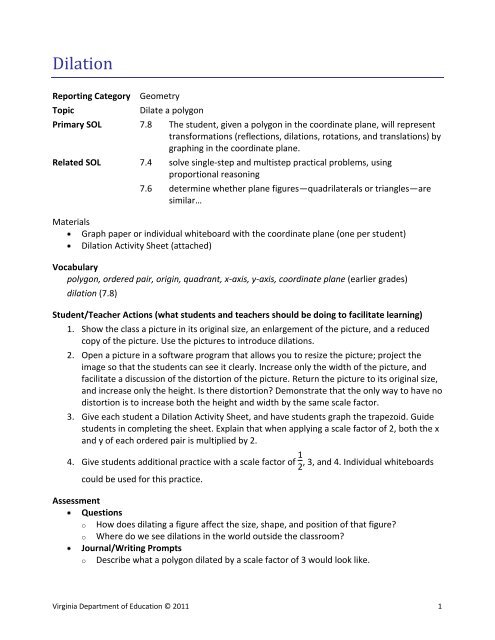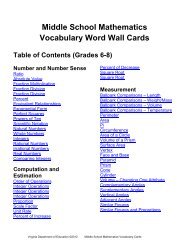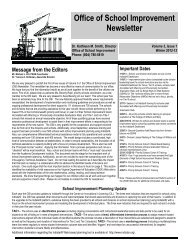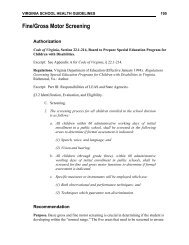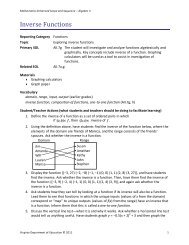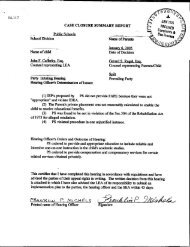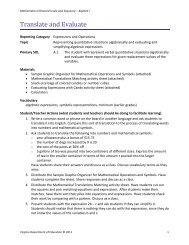Dilation; Geometry; 7.8 - Virginia Department of Education
Dilation; Geometry; 7.8 - Virginia Department of Education
Dilation; Geometry; 7.8 - Virginia Department of Education
Create successful ePaper yourself
Turn your PDF publications into a flip-book with our unique Google optimized e-Paper software.
<strong>Dilation</strong><br />
Reporting Category <strong>Geometry</strong><br />
Topic Dilate a polygon<br />
Primary SOL <strong>7.8</strong> The student, given a polygon in the coordinate plane, will represent<br />
transformations (reflections, dilations, rotations, and translations) by<br />
graphing in the coordinate plane.<br />
Related SOL 7.4 solve single-step and multistep practical problems, using<br />
proportional reasoning<br />
7.6 determine whether plane figures—quadrilaterals or triangles—are<br />
similar…<br />
Materials<br />
Graph paper or individual whiteboard with the coordinate plane (one per student)<br />
<strong>Dilation</strong> Activity Sheet (attached)<br />
Vocabulary<br />
polygon, ordered pair, origin, quadrant, x-axis, y-axis, coordinate plane (earlier grades)<br />
dilation (<strong>7.8</strong>)<br />
Student/Teacher Actions (what students and teachers should be doing to facilitate learning)<br />
1. Show the class a picture in its original size, an enlargement <strong>of</strong> the picture, and a reduced<br />
copy <strong>of</strong> the picture. Use the pictures to introduce dilations.<br />
2. Open a picture in a s<strong>of</strong>tware program that allows you to resize the picture; project the<br />
image so that the students can see it clearly. Increase only the width <strong>of</strong> the picture, and<br />
facilitate a discussion <strong>of</strong> the distortion <strong>of</strong> the picture. Return the picture to its original size,<br />
and increase only the height. Is there distortion? Demonstrate that the only way to have no<br />
distortion is to increase both the height and width by the same scale factor.<br />
3. Give each student a <strong>Dilation</strong> Activity Sheet, and have students graph the trapezoid. Guide<br />
students in completing the sheet. Explain that when applying a scale factor <strong>of</strong> 2, both the x<br />
and y <strong>of</strong> each ordered pair is multiplied by 2.<br />
4. Give students additional practice with a scale factor <strong>of</strong> 1<br />
2<br />
, 3, and 4. Individual whiteboards<br />
could be used for this practice.<br />
Assessment<br />
Questions<br />
o How does dilating a figure affect the size, shape, and position <strong>of</strong> that figure?<br />
o Where do we see dilations in the world outside the classroom?<br />
Journal/Writing Prompts<br />
o Describe what a polygon dilated by a scale factor <strong>of</strong> 3 would look like.<br />
<strong>Virginia</strong> <strong>Department</strong> <strong>of</strong> <strong>Education</strong> © 2011 1
Other<br />
o Give students a polygon and its dilation. Ask students to describe the dilation.<br />
Extensions and Connections (for all students)<br />
Have students design posters that include the definitions and examples <strong>of</strong> each<br />
transformation.<br />
Strategies for Differentiation<br />
Use a chart to record the original ordered pair and the new ordered pair.<br />
(2,2) (3,4) (5,2) (5,4)<br />
Dilate x2<br />
Dilate x3<br />
Dilate x4<br />
Enlarge the coordinate plane.<br />
<strong>Virginia</strong> <strong>Department</strong> <strong>of</strong> <strong>Education</strong> © 2011 2
<strong>Dilation</strong> Activity Sheet<br />
Name Date<br />
1. Graph and connect these points: (2,2) (3,4) (5,2) (5,4).<br />
y<br />
2. Graph a new figure on the same coordinate plane by applying a scale factor <strong>of</strong> 2. When<br />
applying a scale factor <strong>of</strong> 2, multiply both the x and the y coordinate <strong>of</strong> each ordered pair by 2.<br />
Compare the original figure to the rotated figure, including coordinate pairs.<br />
__________________________________________________________________________<br />
3. Graph a new figure on the same coordinate plane by applying a scale factor <strong>of</strong> 1<br />
2<br />
to your<br />
original coordinates. Compare the original figure to the rotated figure, including coordinate<br />
pairs.<br />
__________________________________________________________________________<br />
4. What happens when you apply a scale factor greater than 1 to a set <strong>of</strong> coordinates?<br />
__________________________________________________________________________<br />
5. What happens when you apply a scale factor less than 1 to a set <strong>of</strong> coordinates?<br />
__________________________________________________________________________<br />
6. Predict what would happen if you applied a scale factor <strong>of</strong> 1 to a set <strong>of</strong> coordinates.<br />
10<br />
8<br />
6<br />
4<br />
2<br />
-10 -8 -6 -4 -2 2 4 6 8 10<br />
-2<br />
-4<br />
-6<br />
-8<br />
-10<br />
__________________________________________________________________________<br />
<strong>Virginia</strong> <strong>Department</strong> <strong>of</strong> <strong>Education</strong> © 2011 3<br />
x


